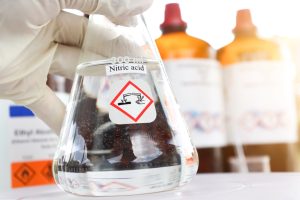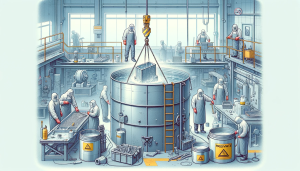
Exploring Nitric Acid (HNO3): Properties, Applications, & Environmental Impact
Share This Post Explore the Multifaceted World of Nitric Acid (HNO3) Nitric acid, a volatile and highly corrosive chemical, has been widely used in

Nitric acid’s role in metal etching across different industries and arts is well established. Those who specialize in nitric acid metal etching are known far and wide for their technical prowess. Its potent chemical properties allow artists and craftsmen to etch intricate designs onto metal surface. In this examination, we reveal the intricate art of using nitric acid for engraving and guide you through best practices in this time-honored craft to take full advantage of its enchanting chemistry.
Being a mineral acid with high corrosivity is an essential feature of nitric acid. Its strong reactivity is exactly why it is loved for engraving metal. This is where we see the product for its incomparable penmanship on metallic boards.
At the molecular level, nitric acid is an oxidant. It acts by oxidizing the surface of metals, and in this process, it generates metal nitrates. Our comprehension of its chemistry enables us to deftly modulate nitric acid’s force both to vary the depth in which an article may be etched and so that we can produce single effects that are ideally tailored for particular customers or their artistic purposes.
Handling nitric acid requires a professional approach. It is important to maintaining the highest health and safety standards, wearing adequate protective equipment, and utilizing suitable facilities. It is responsible to create a protected environment as far as possible since there is the risk inherent in acid fumes or their caustic properties that a person may suffer injury accidentally.
Cleaning and Degreasing Surfaces
The preparation of a metal for engraving begins with a comprehensive cleaning to ensure that impurities will not interfere with the etching process. With specialized degreasing agents, we thoroughly remove contaminants, preparing a clean surface ready for the application of nitric acid.
Standard Application Techniques for Nitric Acid
Skills and a steady hand are needed to handle nitric acid. The process involves meticulously dripping the acid onto a designated surface, ensuring precise application and control. This technique allows for the detailed extraction of information from the surface being treated. We leveraging the unique properties of nitric acid by create intricate designs with confidence and precision, mitigating the risk of unexpected outcomes.
Copper and Steel-Specific Combinations
For copper etching uses ferric chloride, or a combination of ferric chloride and hydrochloric acid or hydrogen peroxide. Clean the copper and apply a resist to the areas you want to etch. Immerse copper for several hours to allow it to etch slowly. A 2:1 hydrochloric acid/hydrogen peroxide mixture is a quicker alternative. Rinse copper, neutralize acid, and remove resist after etching.
Steel etching typically uses nitric acid, or a 3:1 mixture of nitric acid + hydrochloric acid + hydrogen peroxide. Prepare steel surface and apply resist. Diluted nitric acid (usually 1 part acid + 3 parts water) is used, and the etching duration depends on the depth desired. Rinse steel, neutralize acid and remove resist.
How to Etch Zinc
The typical acid strength for etching is 6 to 8 parts water to 1 part nitric acid. The more diluted the acid, the slower the reaction between the acid and the plate. Apply to the areas where you want etching to be done. This can be done using various techniques such as painting, drawing, or dipping, depending on the desired design.
Alternative Non-Toxic Mordants
Nitric acid is very effective, but we also understand the importance of eco-friendly alternatives. Nontoxic mordants, like salt solutions, are alternatives that we use responsibly, ensuring eco-friendliness while still providing high-quality etchings.
Where to Buy High-Quality Nitric Acid for Engraving
We obtain our nitric acid from trusted suppliers who can vouch for the purity of the materials used by us. The acid meets all exacting criteria for purity and suitability.
Manufacture of Ultra-Pure Reagent Grade Acid
The process is carefully monitored which regulates the process of manufacturing pure nitric acid. The use of only the highest quality materials ensures that no impurities will be introduced into your product, so that when it comes out dissolved in water or any other solvent, it will always be clear and free from any kind of visible contamination. Only by strictly sticking to fractional distillation and never allowing impurities or undesirable elements of any sort to enter the mixture.
Nitric Acid Storage and Handling
The storage and handling of nitric acid are as critical as its usage. Correct storage solutions are employed to prevent degradation of the acid and ensure safety in the workshop. We store acid in designated non-reactive containers, safeguarding it from contaminants and ensuring longevity.
Aesthetic Enhancements and Practical Applications
Nitric acid etching can decorate and improve the relatively function of metal surfaces. It is not just our skill that allows us to both ornament and provide something usable or durable.
Characteristics of the etched surface
After etching, the changes in appearance and structure of the metal are far more important than its electrical properties. Nitric acid etching endows the metal with modified reflectivity, variations in surface feel or tactility, as well as increased bonding to coatings.
Customizing by Acid Etching
The art of nitric acid etching provides a custom-made finishes on any metal surface to precisely meet the customer’s requirements. Through this method it brings the essence of character differentiation and invention to metal.
Thus, nitric acid becomes a key element in our engraving toolbox. We use it to bridge the gap between more ancient techniques of workmanship and modern skill, transforming raw metals into works of art or precision components. Through our experience and attention to safety, we refine the highest levels of detail, and through all this, engraving with nitric acids has itself become a trade where the past meets the future—the alchemy of art and industry.
Reference
1. Etching Acids Recipes | Ironbridge Fine Arts and Framing
2. The Acid Etching | Double Stone Steel
3. Alchemie Labs research with AI assist

Share This Post Explore the Multifaceted World of Nitric Acid (HNO3) Nitric acid, a volatile and highly corrosive chemical, has been widely used in

Share This Post Hydrochloric Acid: The Importance of Purity for Metal Refining Hydrochloric acid has served as a tool for the refining industry since

Share This Post The Advantages Unlocked by Pickling and Passivation in Metal Treatment When it comes to metal fabrication and maintenance, the terms “pickling” and
Expect a friendly letter from us once a month. No spam.
Copyright © 2024 Alchemie Labs. All rights reserved.